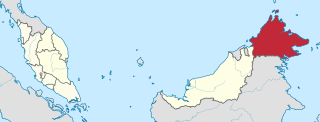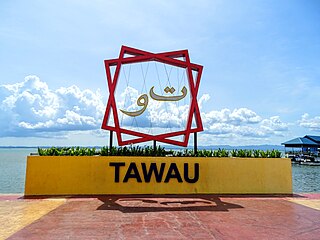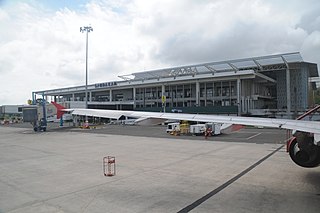
Sabah is a state of Malaysia located in northern Borneo, in the region of East Malaysia. Sabah has land borders with the Malaysian state of Sarawak to the southwest and Indonesia's North Kalimantan province to the south. The Federal Territory of Labuan is an island just off Sabah's west coast. Sabah shares maritime borders with Vietnam to the west and the Philippines to the north and east. Kota Kinabalu is the state capital and the economic centre of the state, and the seat of the Sabah State government. Other major towns in Sabah include Sandakan and Tawau. The 2020 census recorded a population of 3,418,785 in the state. It has an equatorial climate with tropical rainforests, abundant with animal and plant species. The state has long mountain ranges on the west side which forms part of the Crocker Range National Park. Kinabatangan River, the second longest river in Malaysia runs through Sabah. The highest point of Sabah, Mount Kinabalu is also the highest point of Malaysia.

North Borneo was a British protectorate in the northern part of the island of Borneo,. The territory of North Borneo was originally established by concessions of the Sultanates of Brunei and Sulu in 1877 and 1878 to a German-born representative of Austria-Hungary, businessman and diplomat, Gustav Overbeck.

Sandakan formerly known at various times as Elopura, is the capital of the Sandakan District in Sabah, Malaysia. It is the second largest city in Sabah after Kota Kinabalu. It is located on the Sandakan Peninsula and east coast of the state in the administrative centre of Sandakan Division and was the former capital of British North Borneo. In 2010, the city had an estimated population of 157,330 while the overall municipal area had a total population of 396,290. The population of the municipal area had increased to 439,050 by the 2020 Census.

Tawau, formerly known as Tawao, is the capital of the Tawau District in Sabah, Malaysia. It is the third-largest city in Sabah, after Kota Kinabalu and Sandakan. It is located on the Semporna Peninsula in the southeast coast of the state in the administrative centre of Tawau Division, which is bordered by the Sulu Sea to the east, the Celebes Sea to the south at Cowie Bay and shares a border with North Kalimantan, Indonesia. The town had an estimated population as of 2010, of 113,809, while the whole municipality area had a population of 397,673. The municipal area had a population of 372,615 at the 2020 Census.

The Ranau District is an administrative district in the Malaysian state of Sabah, part of the West Coast Division which includes the districts of Kota Belud, Kota Kinabalu, Papar, Penampang, Putatan, Ranau and Tuaran. The capital of the district is in Ranau Town. The landlocked district bordering the Sandakan Division to the east until it meets the Interior Division border. Ranau sits 108 km (67 mi) east of Kota Kinabalu and 227 km (141 mi) west of Sandakan. As of the 2010 Census, the population of the district was 94,092, an almost entirely Dusun ethnic community.

Papar is the capital of the Papar District in the West Coast Division of Sabah, Malaysia. Its population was estimated to be around 124,420 in 2010, which is divided between Bruneian Malay, Kadazan-Dusun, and Bajau. There is also a sizeable Chinese minority, predominantly of the Hakka subgroup, as well as smaller numbers of other races. The town is located 38 kilometres south of the state capital of Kota Kinabalu, with the Papar railway station in the town becoming one of the main stops of the Sabah State Railway.

Keningau is the capital of the Keningau District in the Interior Division of Sabah, Malaysia. It is the fifth-largest town in Sabah, as well one of the oldest. Keningau is between Tambunan and Tenom. The town had an estimated population of 173,130. Dusuns, Muruts and Lundayehs is the major ethnics in Keningau.

Sandakan Airport is a domestic airport located in Sandakan, Sabah, Malaysia, approximately 14 km (8.7 mi)) west of the town center. It serves as an important gateway for both passenger and cargo traffic, supporting the local economy and regional tourism. In 2022, the airport handled 621,513 passengers and recorded 10,876 flight movements, making it the 12th busiest airport in Malaysia.

Agnes Newton Keith was an American writer best known for her three autobiographical accounts of life in North Borneo before, during, and after World War II. The second of these, Three Came Home, tells of her time in Japanese prisoner-of-war camp and civilian internee camp in North Borneo and Sarawak, and was made into a film of the same name in 1950. She published seven books in all.

The history of Sabah can be traced back to about 23–30,000 years ago when evidence suggests the earliest human settlement in the region existed. The history is interwoven with the history of Brunei and the history of Malaysia, which Sabah was previously part of and is currently part of respectively. The earliest recorded history of Sabah being part of any organised civilisation began in the early 15th century during the thriving era of the Sultanate of Brunei. Prior to this, early inhabitants of the land lived in predominantly tribal societies, although such tribal societies had continued to exist until the 1900s. The eastern part of Sabah was ceded to the Sultan of Sulu by the Sultan of Brunei in 1658 for the former helping a victory over Brunei enemies, but many sources stated it had not been ceded at all. By the late 19th century, both territories previously owned by Sultan of Brunei and Sultan of Sulu was granted to British syndicate and later emerged as British North Borneo under the management of the North Borneo Chartered Company. Sabah became a protectorate of the United Kingdom in 1888 and subsequently became a Crown colony from 1946 until 1963, during which time it was known as Crown Colony of North Borneo. On 16 September 1963, Sabah merged with Malaya, Sarawak and Singapore to form Malaysia.

Jalan Tun Perak, formerly Jalan Mountbatten (1961–1981) Mountbatten Road (1946–1961) and Java Street (1889–1946), is a major road located in the historic centre of Kuala Lumpur, Malaysia. It was a major commercial street of early Kuala Lumpur, and is now the location of a few financial institutions. The entry to the Jamek Mosque is located here, and the light rapid transit stop on this street is Masjid Jamek LRT station.

The Chartered Company Monument is a monument in the town of Sandakan in Sabah, Malaysia dedicated to the British servicemen or employees who were killed at the end of the 19th century. The monument was built by the British North Borneo Company and part of the Sandakan Heritage Trails, a trail which connects the historic sights of Sandakan.

Sandakan Heritage Trail is a trail connecting several historical sites in Sandakan, a town in the east Malaysian state of Sabah. It is marked with white concrete tiles placed on the ground showing a red footprint the words "Heritage Trail" in either black or gold.

The Parish of St. Michael's and All Angels or for short St. Michael's Church is an Anglican church in the city of Sandakan in the Malaysian state of Sabah in northern Borneo. St. Michael is the oldest stone church in Sabah. The impetus for the construction of the church dates back to the clergyman William Henry Elton, who is also known as the founder of St. Michael's Secondary School, located next to the church.

The Sandakan District Mosque is a mosque in Sandakan, Sabah, Malaysia. Built in 1985 and completed in 1989, it is the main mosque for the district of Sandakan. The mosque was officially opened in 1990.

Sam Sing Kung Temple (also known as the Three Saints Temple) is a Chinese temple in Sandakan, Sabah, Malaysia. Built in 1887, the temple is the third oldest temple in Sandakan, after Goddess of Mercy Temple and Tam Kung Temple. It is part of the Sandakan Heritage Trail.

Jamek Mosque, officially Sultan Abdul Samad Jamek Mosque is one of the oldest mosques in Kuala Lumpur, Malaysia. It is located at the confluence of the Klang and Gombak rivers and may be accessed via Jalan Tun Perak. The mosque was designed by British architect and soldier Arthur Benison Hubback, and built in 1909. It was the principal mosque of Kuala Lumpur until the construction of the national mosque Masjid Negara in 1965.

The Sandakan District is an administrative district in the Malaysian state of Sabah, part of the Sandakan Division which includes the districts of Beluran, Kinabatangan, Sandakan, Telupid, and Tongod. The capital of the district is in Sandakan City.

Sandakan Japanese Cemetery is an old graveyard in Sandakan, Sabah, Malaysia. Located on a hill about 2 kilometres from the town's central business district, it is a cemetery where the remains are buried of many Japanese female prostitutes called Karayuki-san from poverty-stricken agricultural prefectures in Japan who were sold into slavery at a very young age years before World War II which also include recent comfort women during the war. It is part of the Sandakan Heritage Trail.

Sandakan Heritage Museum is a museum located at the 1st floor of Wisma Warisan building in Sandakan of Sabah, Malaysia. The museum building is located next to the Sandakan Municipal Council and is part of the Sandakan Heritage Trail.




















